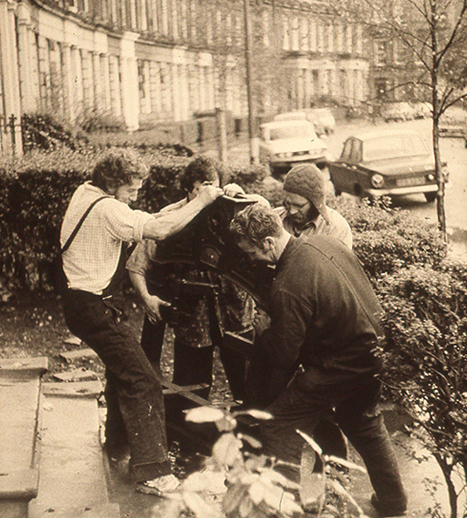43 St Vincent Crescent 1972 - 1976
- 1972
- The Print Studio is set up by a group of students and graduates from the Glasgow School of Art: Bill Blacker, Jimmy Cosgrove, John Faulds, Beth Fisher, Sheena McGregor, Eileen Ormiston and Jacki Parry with the assistance of Philip Reeves. These are the eight founding members (Directors) of the organisation.
- 1973
- First official meeting of the Council of Management. Philip Reeves is Chairman and Beth Fisher is the Company Secretary.
- 1974
- Glasgow Print Studio exhibition held at the Fruitmarket Gallery, Edinburgh
- 1975
- Visiting American artist Ron Glassman hosted by the Studio. Beth Fisher leaves for a role at Glasgow School of Art and Calum MacKenzie is employed as Workshop Manager. New, larger premises are sought.
- 1976
- The Print Studio moves out of St Vincent Crescent.

Image: Taking a press down the steps of St Vincent Crescent during the move to Ingram Street in 1976. The man wearing the hat is Calum Mackenzie (© Glasgow Print Studio, ref GLAPS.2011.390)
Listen:
The Story:
The story of Glasgow Print Studio begins in a tenement flat in the City’s Finnieston area. Around 1971, a group of students from the Glasgow School of Art printmaking department started discussing the possibility of a premises where they could continue to make prints after graduation. Despite the specialist printmaking course offered at Glasgow, there were no outside facilities available for graduates to use. Printmaking Head of Department Philip Reeves was keen to help establish a workshop in the city – he had previously helped to found Edinburgh Printmakers in 1967. Beth Fisher, an American printmaker who also taught at the Art School, had a motorised etching press which she was able to lend so that others could benefit from it, in a communal set up.
Early discussions among a group of final year and graduate students led to the search for a suitable location. This was found by Sheena McGregor in the Glasgow Herald newspaper - a former electrician’s unit listed as a commercial property. At that time, the area around St Vincent Crescent was home to a variety of commercial and industrial businesses. The premises were bare and required a lot of manual labour by the founders to get it ready to open for use. A main door entry flat on the ground floor with basement access, it was reconfigured by the group to become a workshop. On entering the hallway there was an etching room on the right and on the left was a large offset lithographic press plus a small space used as an office. Screenprint facilities were at the back but later moved downstairs to the basement when that was renovated.

Sheena and Beth shared the running of the workshop, taking on the day to day issues as well as the more strategic issues of sourcing funding and planning development of the Studio. The basement area was cleared of rubbish, the floors were levelled, a damp course laid and cement was poured to increase the working area. All the work was done by people involved with the Studio and everyone helped with the manual labour, with many favours were called in. Others who worked at the Studio included Bill Blacker, who combined teaching evening and weekend classes with his part-time art teaching role. Jacki Parry and Elspeth Lamb were involved with editioning and supported the running of the workshop. Rab McInnes and John Taylor both worked in screenprint.
In the early days, advice was taken from both Edinburgh Printmakers and the Scottish Arts Council, particularly the Visual Arts Officer Bill Buchanan. The GSA were supportive with an initial donation of £50 from the SRC (Student Representative Council), and in addition to Beth Fisher’s loaned press, the Art School passed on an etching press when they bought a new one for the department. Financial support came from Scottish Arts Council and a grant from the Gulbenkian Foundation allowed the purchase of a second-hand off-set lithography press, a copy camera and screenprint bed.

The aims of Glasgow Print Studio, as set out in the original 1973 Articles of Association (and which still stand today) are:
i) To promote, maintain, improve and advance education particularly by the encouragement of the study, practice and knowledge of the art of printmaking and to provide facilities for the practice by any member of the association (Glasgow Print Studio) of such graphic techniques as etching, lithography, silkscreen printing, woodcutting and other graphic processes and for the exhibition of works produced by these techniques and the sale of prints and to formulate, prepare and establish schemes provided that all the objects of the association are of a charitable nature.
ii) To present, promote, organise, provide, manage and produce films, broadcasts, entertainments and exhibitions which are conducive to the promotion, maintenance, improvement and advancement of education or to the encouragement of the Arts.
By mid-1974 there were 50 regular workshop users, gained by word of mouth and newspaper adverts. Artists regularly using the workshop included Ronnie Forbes, Gregor Smith, Carole Bowen, Rita McGurn, Christine Doyle and Joe Urie. Art critic Clare Henry began using the workshop in 1973 and went on to serve as Council of Management Secretary, and later Chairperson in the late 1970s. Her affection for the Print Studio continued when she became art critic at the Glasgow Herald in 1980, and she was always an enthusiastic supporter of Print Studio artists and exhibitions.
Now more established, the Studio was commissioning prints and producing editions for artists, including John Byrne and Alasdair Gray. Chris Carrell from Third Eye Centre commissioned the Print Studio make an edition of four Poster Poems, which was the beginning of a fruitful relationship between the two organisations. The ‘Rent a Print’ scheme was another way to promote printmaking and raise revenue. The same year, a grant of £500 from Scottish Arts Council went to concreting basement floors to make a screenprint area and darkroom.
Later in the year, the Gulbenkian Foundation gave £9,906 over three years "to develop the education work of the Studio by establishing regular evening and weekend classes from ad hoc work already initiated, particularly for those who hope to adopt printmaking as a career.” These classes were a vital way to make the workshop accessible to those who had not been to Art School, and evening and weekend classes are still regularly held at the Print Studio. Another important work strand that began around this time was allowing school groups to access the workshop, such as the pupils who were brought by artist Brian McGeoch from the deprived Barrowfield area in the East of Glasgow.
Despite the lack of dedicated display space, the Studio still held ‘openings,’ with prints pinned up round the presses and in the hallway. In June 1974 Glasgow Print Studio even hosted a travelling exhibition from Edinburgh Printmakers, and in turn, exhibited at Edinburgh's Fruitmarket Gallery. The organisation’s reputation was growing, and so were its ambitions. Following Beth Fisher’s departure for a new role in 1975, Calum MacKenzie took up the role as Manager. As part of the artist’s co-operative, the Glasgow League of Artists, Calum had good connections and great ambitions for the Print Studio – more print publications, ambitious events, collaborations with artists and writers. But first, new premises were sought.





